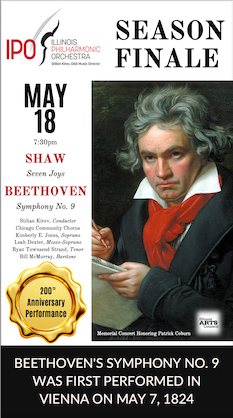Gerstein launches Beethoven sonata cycle with insight, panache

Just a couple hours after the Chicago Marathon concluded Sunday, a different kind of marathon began with Kirill Gerstein launching Symphony Center’s season-long cycle of the complete Beethoven piano sonatas.
The ambitious project marking the composer’s 250th birthday season will encompass all 32 sonatas and the “Diabelli” Variations, performed by seven of the world’s finest keyboard artists in nine recitals through next May.
Gerstein’s leadoff program took a big chomp out of the cycle, presenting five sonatas in total and flanking a pair of substantial early works with three middle-period sonatas.
As one would expect from a pianist of his caliber, Gerstein showed himself a fine Beethoven interpreter, with insightful, boldly projected playing that consistently inhabited the spirit of the composer, even when one was less convinced by some tempos.
Gerstein opened with the Sonata No. 2 in A major, the middle work of Beethoven’s Op. 2 set containing the first three published piano sonatas. One digital slip apart, the pianist was in synch with the prevailing light-hearted spirit of this early (1795) work in the opening movement, bringing out the easygoing humor of the jokey contrasts and false endings.
Gerstein conveyed the rippling playfulness of the Scherzo and the Rondo finale went with vitality even if it missed some of the relaxed grazioso spirit Beethoven indicated. The slow movement was less successful—far too rushed and prosaic for deeply introspective music marked “Largo appassionato.”
The ensuing Sonata No. 16 in G major (Op. 31, no.1) proved more consistent. Gerstein brought a witty self-satisfied air to the skipping main theme, charting the abrupt breakouts into restless flurries of notes. The Adagio was fluently rendered, albeit with rather straitened dynamics, and the charm and wit of the hectic Rondo surely conveyed, some rhythmic unsteadiness apart.
After a welcome retuning at intermission, the Steinway sounded less murky, brighter and better focused, setting the stage for the three closing works, which showed Gerstein’s Beethoven to best advantage.
Despite the late opus numbers, the two brief Op. 49 sonatas are early works from the 1790s, written before the published Op. 2 set. Gerstein brought out the Mozartean influence of the first of these, the Sonata No. 19 in G minor, while also underlining the Haydnesque quirk of the harmonic curveballs and surprise dynamic flips. The off-kilter Rondo was especially delightful in Gerstein’s hands, tossed off with mercurial exuberance.
Sandwiched between the “Waldstein” and “Appassionata,” the Sonata No. 22 in F major, Op. 54, is among the least played of all Beethoven sonatas. Yet though this two-movement work is half the length of its middle-period neighbors, strangenesses abound as Beethoven begins to hammer and shape sonata structure to fit his musical ends rather than the other way around. Gerstein had a sure sense of this sonata’s unorthodox character, the classical minuet theme quickly morphing into disruptive outbursts of loud octaves and jarring cross-rhythms. Likewise, despite the amiably cascading flow of notes in the concluding Allegretto, the music builds up a daunting head of steam, strikingly so in Gerstein’s hands.
And so on to the Sonata No. 4 in E flat major, Op. 7, Beethoven’s first grandly scaled work in the genre. Only the epic “Hammerklavier”—which would come 22 years later—is longer of all the 32 sonatas.
Gerstein saved his finest playing of the afternoon for Op. 7. The first movement’s rushing torrent of themes and material are almost bewildering; yet Gerstein’s clarity and forcefully projected perfomance consistently pressed the musical argument forward without sacrificing any of Beethoven’s jaunty, see-what-I-can-do panache. The pianist brought rich, spacious playing to the vast Largo, exploring the music’s striking depth of feeling with searching, unsentimental expression.
The light-hearted caprice of the Scherzo brought us to the final movement—amiably grazioso as marked, with the agitated thunderbolt volleys of the middle section given ample power, before Gerstein rounded off the sonata and the program with a delectably nonchalant coda.
Such a substantial and demanding recital would have been sufficient for most pianists. But responding to the enthusiastic ovation, Gerstein offered nothing less than Beethoven’s epic “Eroica” Variations for an encore. He joked, “If some of you are in a hurry, I won’t hold it against you.”
Few elected to leave during this 20-minute showpiece. Gerstein delivered an organic yet wonderfully characterful performance, each bravura iteration vividly differentiated and closing with a thrilling display in the fugal finale.
Symphony Center Presents’ Beethoven Sonata cycle continues November 6 with Rudolf Buchbinder performing Sonatas Nos. 5-7 and 18. cso.org; 312-294-3000.
Posted in Performances





